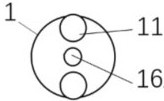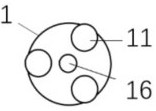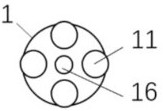Pneumatic separation recoverable carrier rocket for launching sub-orbital load
A technology for aerodynamic separation and launch vehicles, applied in the field of aerospace rockets, can solve problems such as high cost, uncontrollable landing point, difficult recovery, etc., to achieve the effect of reducing costs, reducing design and manufacturing costs, and ensuring normal operation
- Summary
- Abstract
- Description
- Claims
- Application Information
AI Technical Summary
Problems solved by technology
Method used
Image
Examples
Embodiment 1
[0051] Example 1: Combined aerodynamic attitude control with a single "double pendulum tube" recovered power engine.
[0052] The recovery power system 16 adopts a two-way swing recovery power engine 161 , and the recovery power engine 161 is installed in the middle of two or more primary power engines 11 evenly distributed in the circumferential direction. The working mechanism of a single "double pendulum tube" recovery power engine combined with aerodynamic attitude control is as follows: (1) In the take-off section of the rocket launch, the recovery power engine 161 and the first-stage power engine 11 are started together, and the booster rocket accelerates; the rocket rises to a certain level. After the altitude, in order to reduce the ascent acceleration of the rocket, the recovery power engine 161 can be shut down in time; during the rocket ascent, the recovery power engine 161 yaw controls the pitch and yaw attitude of the rocket, and the pneumatic separation attitude c...
Embodiment 2
[0053] Example 2: A single "non-swing tube" recovery power engine is combined with aerodynamic attitude control.
[0054] The recovery power engine 161 is installed in the middle position, and there are two or more primary power engines 11 evenly distributed in the circumferential direction of the recovery power engine 161 . During the ascent and descent of the rocket, attitude control of the rocket's pitch, yaw and roll is completed by the attitude control function of the pneumatic separation attitude control device 65 . The working mechanism of the rocket power system is as follows: (1) In the take-off section of the rocket launch, the recovery power engine 161 and the first-stage power engine 11 are started together, and the booster rocket accelerates upward; after the rocket rises to a certain height, in order to reduce the rocket's rising acceleration, the recovery power The engine 161 can be shut down in time; before the rocket is recovered and landed at a certain height...
Embodiment 3
[0056] Embodiment 3: "one recovery and two main hairs", such as Figure 1A As shown, the first-stage power engine 11 adopts two engines, and a regenerative power engine is arranged in the middle. The number of two engines, two big, one small and three engines is the least, but the straight line space of the nozzles of the three engines is the largest, and the requirements for the diameter of the arrow body or the installation space of the engine are the largest; at this time, the first-level power engine or its nozzle may protrude to the first-level arrow body. Outside the arrow wall (casing), it is not conducive to the engine layout. It is less difficult to control a single regenerative power engine. Therefore, the cost of this three-engine solution is lower.
PUM
 Login to View More
Login to View More Abstract
Description
Claims
Application Information
 Login to View More
Login to View More - R&D
- Intellectual Property
- Life Sciences
- Materials
- Tech Scout
- Unparalleled Data Quality
- Higher Quality Content
- 60% Fewer Hallucinations
Browse by: Latest US Patents, China's latest patents, Technical Efficacy Thesaurus, Application Domain, Technology Topic, Popular Technical Reports.
© 2025 PatSnap. All rights reserved.Legal|Privacy policy|Modern Slavery Act Transparency Statement|Sitemap|About US| Contact US: help@patsnap.com



